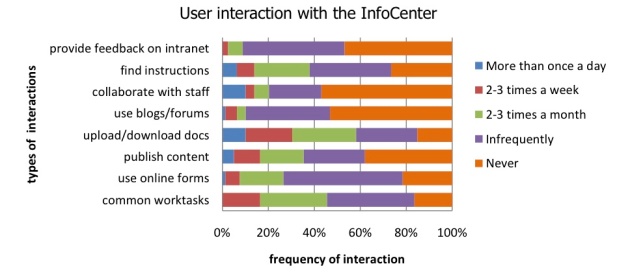Intranet Content Tug-of-War
May 18, 2011 3 Comments
There are many challenges we face as Intranet/Content Managers. I have two in particular surrounding Intranet Content that I am facing now and so I appeal to you, the wider Intranet Community, what are your thoughts and experience in these. I will attempt to clarify my thoughts and articulate them as concisely as possible…
1. Push for Corporate news & info prominence
Traditionally intranets were a place where internal coms, marketing and the like would push out corporate news and information and we as employees were merely consumers forced to read the facade of information that was made available. Intranets today are shifting from this and are more of an even ground that allow information to flow both ways, with social media and user-centric designs taking the lead and changing the way work in very big ways. And, in an ideal world, if I could be so bold to propose, we would all have micro-blogging streams to help us keep track of what our colleagues were doing, what projects they worked on and what our leaders wanted to say.
From recent intranet tours and screenshots that I have seen through events such as IBF24, WIC Case Studies (you need to be a WIC member to access these) and nSynergy seminars I see a growing trend where the formerly dominant internal coms, news and info are taking a back seat to features that help employees connect with each other and facilitate the way they work.
So the question that I am posing is how necessary is it to still have information such as “About Us” on an intranet, when a large portion of that information would be available via the company’s external facing website?
If it is important to still cover this info, how much effort should we be spending on creating or re-creating it for the internal audience? Are there better ways to do this using newer more social intranet features?
2. Driving forces behind the wheel
My second challenge stems from the above and goes into how much should individual teams like Marketing, Internal Communications, HR or IT influence the intranet in terms of content and architecture? While intranets are maturing and need to become multi-faceted, many still sit within one of the above mentioned business units, resulting in siloed approaches to driving and developing the intranet. The likely outcome would be a lopsided solution to function, design and content.
My approach to this was to establish an intranet steering committee, and I have an even representation from Marketing/Internal Coms, HR and IT all grappling for the steering wheel. It will be interesting to see if the parent business unit still carries enough weight to steer the intranet in the final direction.
Who will win the war?
My frustrating predicament leaves me pondering… what is the future for intranet professionals? Where do we fit in an organisational structure? Will we remain under the strong and often biased influence of our parent business unit (often IT, Marketing/Coms or HR) or will we break free and flourish – influencing and innovating the way we work?



